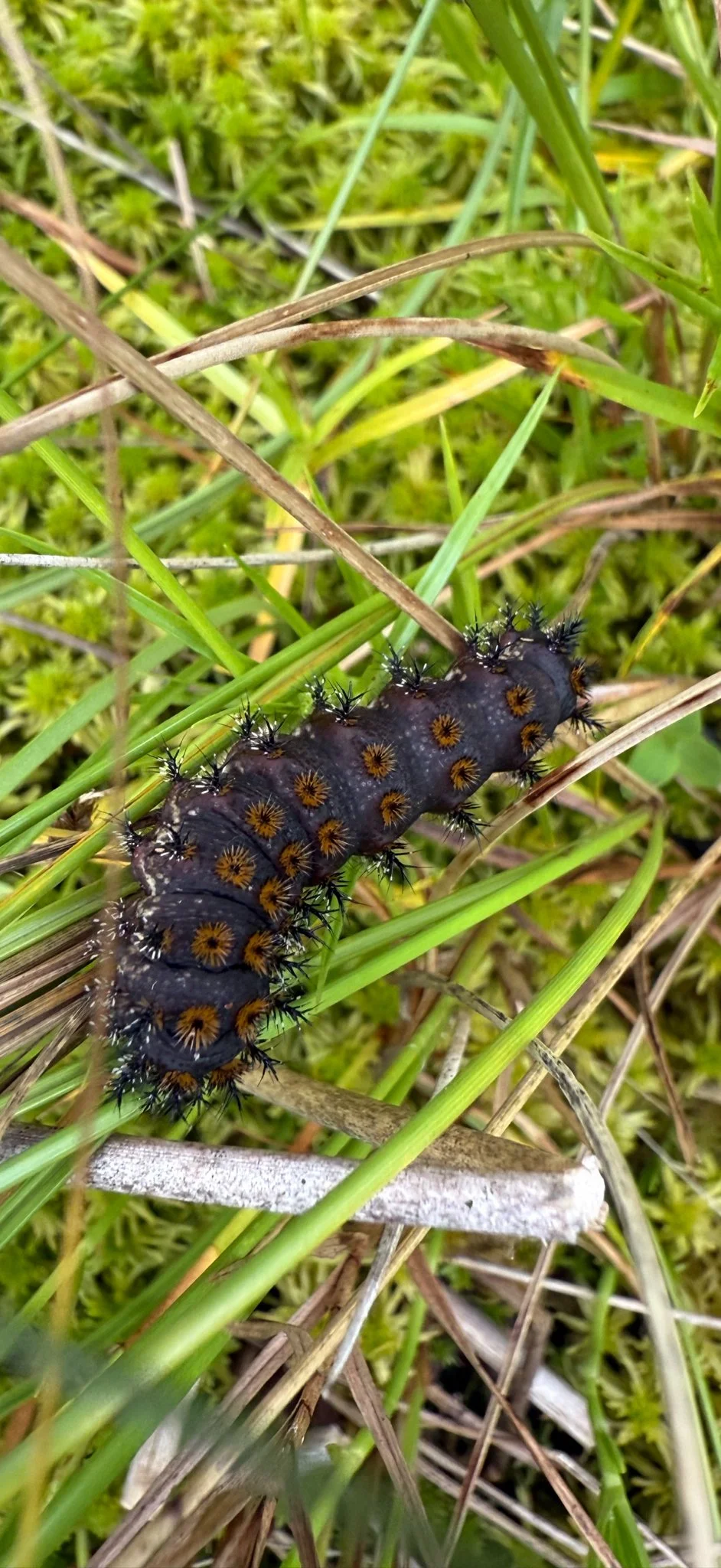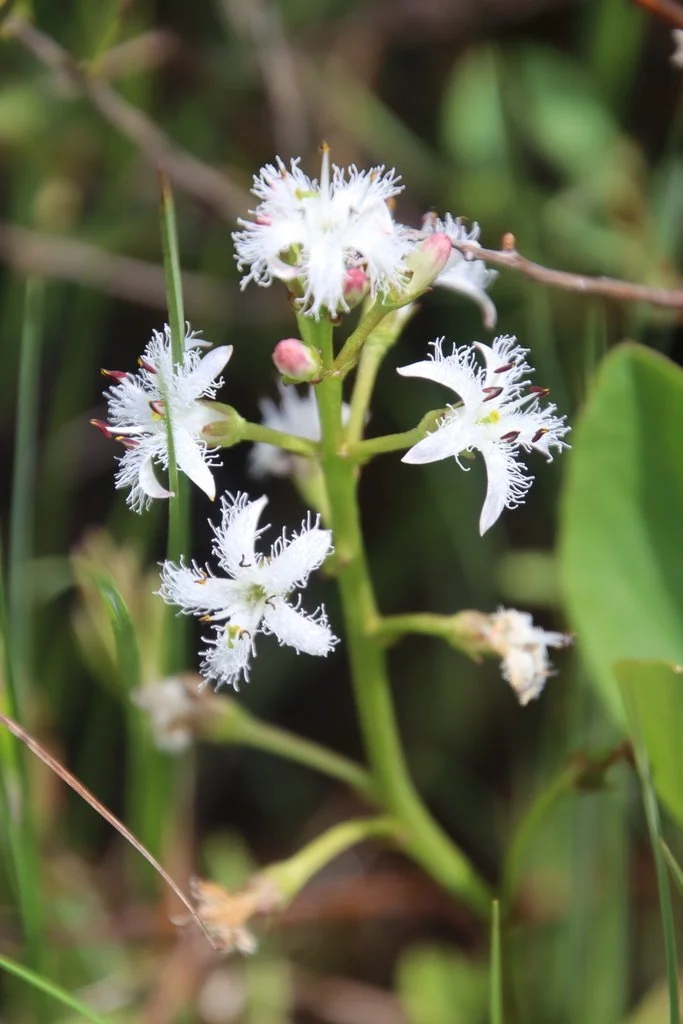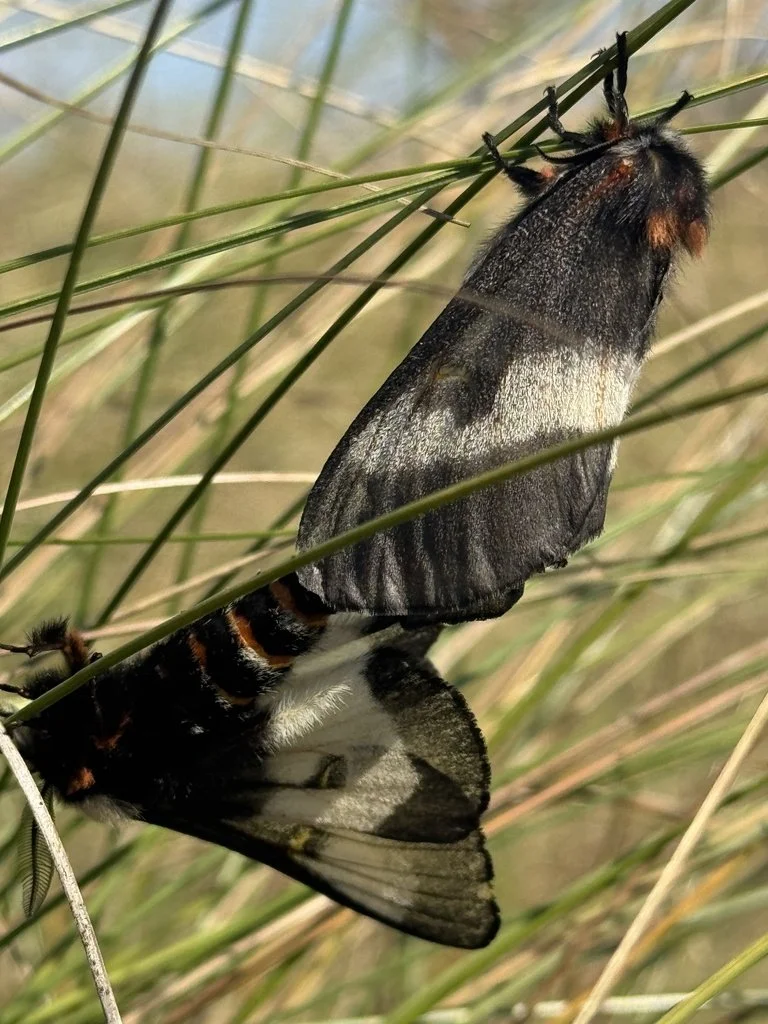The spiky purple caterpillar found by intern Nate Caruccio during a hike at Faville Grove in summer 2025 (photo by Jeff Steele/SoWBA).
Earlier this summer, during a botanical field trip into one of Faville Grove Sanctuary’s bogs, one of our interns stopped abruptly. “What is that?” he asked, crouching over a patch of sedges. Resting on a stem was a caterpillar—its dark violet body gleamed beneath black with beautiful branching spines that rose from bright orange bases. None of us had ever seen anything like it. Later, when I shared photos with a few entomologist friends, the verdict that came back was that the mysterious larva belonged to the bogbean buckmoth (Hemileuca menyanthevora), one of North America’s rarest moths.
Faville Grove’s bogs are time capsules—living remnants of the Ice Age. More than 10,000 years ago, retreating glaciers left behind blocks of buried ice that melted into kettle depressions, slowly filling with peat from centuries of decaying sphagnum moss. Cut off from nutrient-rich groundwater, these basins became acidic, oxygen-poor ecosystems where only the hardiest species survive. Many of the plants and animals found here have northern affinities, persisting in Wisconsin as relics from a colder, wetter time.
Bogbean (photo by Jeff Steele/SoWBA).
Just as monarchs rely on milkweed, bogbean buckmoths depend entirely on bogbean (Menyanthes trifoliata). Despite its name, bogbean isn’t a bean at all. The “bean” refers to its three-parted leaves, which resemble broad beans. Possessing a bitter flavor, once used in Europe as a hop substitute for brewing, bogbean grows only in intact bogs. Not every bog harbors bogbean—but Faville Grove’s do, adding another piece of evidence that helped determine our caterpillar’s identity.
Months later, while collecting seeds on the edge of the same bog, I noticed something large and dark flying low over the sedges. I went in for a closer look and realized there were hundreds of moths clumsily flying around the tamarack forest in the bog's interior—the bogbean buckmoths had emerged!
Bogbean buckmoths, with dark wings banded with white and flashes of orange on the abdomen (photo by Jeff Steele/SoWBA).
With black wings boldly banded in white, flashes of orange along the abdomen, and a wingspan nearly the length of a finger, the bogbean buckmoth is striking. Seeing dozens coursing over the bog in the autumn sun left no doubt: Faville Grove supports a population of this very rare moth. In 2023, the US Fish & Wildlife Service listed the bogbean buckmoth as federally endangered, one of only three moths in the nation to hold that status. Once abundant across the Great Lakes region, the species has disappeared from most of its range due to wetland drainage, invasive plants, fluctuating water levels, and a rapidly changing climate. The largest remaining populations persist in New York and Ontario, with only a handful of others known elsewhere.
The moths’ entire life cycle is tuned to bog rhythms: overwintering as eggs, hatching in spring, feeding and pupating through summer, and taking wing in late September. Female buckmoths lay a ring, or “cuff,” of eggs around the stem of a host plant in fall. The black, spiny caterpillars that hatch in spring feed together in tight clusters. Their shared darkness may help them absorb warmth in the cold bog during spring, and their massed spines offer safety in numbers. As they grow, they disperse—some are even observed swimming from one bogbean stem to another. By midsummer, they pupate in the peat, waiting underground until fall to emerge once more. Adults live only briefly—males for a few days, females sometimes just one—before laying their eggs and beginning the cycle anew. I was lucky to witness their emergence.
Here, an Ice Age relic dependent on a bog-specialist plant still endures—a delicate thread of life connecting our present to the Pleistocene. The presence of this rare, resilient species in our sanctuary is a powerful reminder of why protecting our landscapes is so important. Who knows what other discoveries remain to those curious enough to look closely at our remnant ecosystems?
Written by Jeff Steele, Faville Grove Sanctuary land steward







